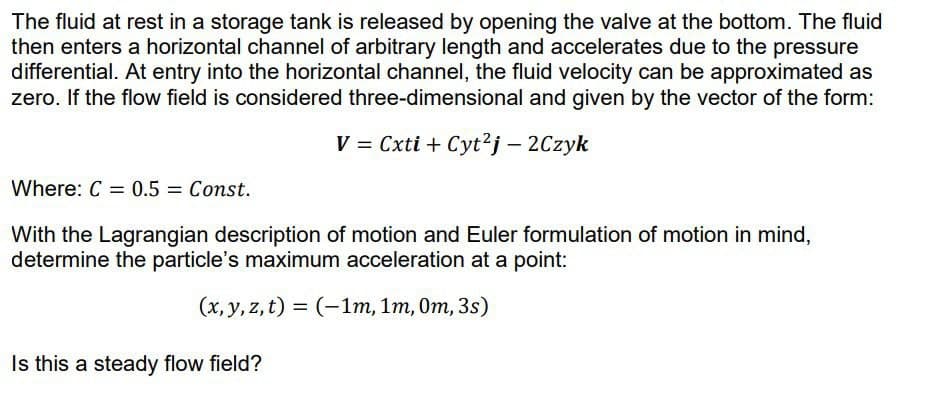The fluid at rest in a storage tank is released by opening the valve at the bottom. The fluid then enters a horizontal channel of arbitrary length and accelerates due to the pressure differential. At entry into the horizontal channel, the fluid velocity can be approximated as zero. If the flow field is considered three-dimensional and given by the vector of the form: V = Cxti + Cyt²j - 2Czyk Where: C 0.5 = Const. = With the Lagrangian description of motion and Euler formulation of motion in mind, determine the particle's maximum acceleration at a point: (x, y, z, t)= (-1m, 1m, 0m, 3s) Is this a steady flow field?
The fluid at rest in a storage tank is released by opening the valve at the bottom. The fluid then enters a horizontal channel of arbitrary length and accelerates due to the pressure differential. At entry into the horizontal channel, the fluid velocity can be approximated as zero. If the flow field is considered three-dimensional and given by the vector of the form: V = Cxti + Cyt²j - 2Czyk Where: C 0.5 = Const. = With the Lagrangian description of motion and Euler formulation of motion in mind, determine the particle's maximum acceleration at a point: (x, y, z, t)= (-1m, 1m, 0m, 3s) Is this a steady flow field?
Elements Of Electromagnetics
7th Edition
ISBN:9780190698614
Author:Sadiku, Matthew N. O.
Publisher:Sadiku, Matthew N. O.
ChapterMA: Math Assessment
Section: Chapter Questions
Problem 1.1MA
Related questions
Question
Alert for not submit AI generated answer. I need unique and correct answer. Don't try to copy from anywhere. Do not give answer in image formet and hand writing

Transcribed Image Text:The fluid at rest in a storage tank is released by opening the valve at the bottom. The fluid
then enters a horizontal channel of arbitrary length and accelerates due to the pressure
differential. At entry into the horizontal channel, the fluid velocity can be approximated as
zero. If the flow field is considered three-dimensional and given by the vector of the form:
V = Cxti + Cyt²j - 2Czyk
Where: C = 0.5 = Const.
With the Lagrangian description of motion and Euler formulation of motion in mind,
determine the particle's maximum acceleration at a point:
(x, y, z, t) = (-1m, 1m, 0m, 3s)
Is this a steady flow field?
Expert Solution
This question has been solved!
Explore an expertly crafted, step-by-step solution for a thorough understanding of key concepts.
Step by step
Solved in 3 steps with 5 images

Knowledge Booster
Learn more about
Need a deep-dive on the concept behind this application? Look no further. Learn more about this topic, mechanical-engineering and related others by exploring similar questions and additional content below.Recommended textbooks for you

Elements Of Electromagnetics
Mechanical Engineering
ISBN:
9780190698614
Author:
Sadiku, Matthew N. O.
Publisher:
Oxford University Press

Mechanics of Materials (10th Edition)
Mechanical Engineering
ISBN:
9780134319650
Author:
Russell C. Hibbeler
Publisher:
PEARSON

Thermodynamics: An Engineering Approach
Mechanical Engineering
ISBN:
9781259822674
Author:
Yunus A. Cengel Dr., Michael A. Boles
Publisher:
McGraw-Hill Education

Elements Of Electromagnetics
Mechanical Engineering
ISBN:
9780190698614
Author:
Sadiku, Matthew N. O.
Publisher:
Oxford University Press

Mechanics of Materials (10th Edition)
Mechanical Engineering
ISBN:
9780134319650
Author:
Russell C. Hibbeler
Publisher:
PEARSON

Thermodynamics: An Engineering Approach
Mechanical Engineering
ISBN:
9781259822674
Author:
Yunus A. Cengel Dr., Michael A. Boles
Publisher:
McGraw-Hill Education

Control Systems Engineering
Mechanical Engineering
ISBN:
9781118170519
Author:
Norman S. Nise
Publisher:
WILEY

Mechanics of Materials (MindTap Course List)
Mechanical Engineering
ISBN:
9781337093347
Author:
Barry J. Goodno, James M. Gere
Publisher:
Cengage Learning

Engineering Mechanics: Statics
Mechanical Engineering
ISBN:
9781118807330
Author:
James L. Meriam, L. G. Kraige, J. N. Bolton
Publisher:
WILEY